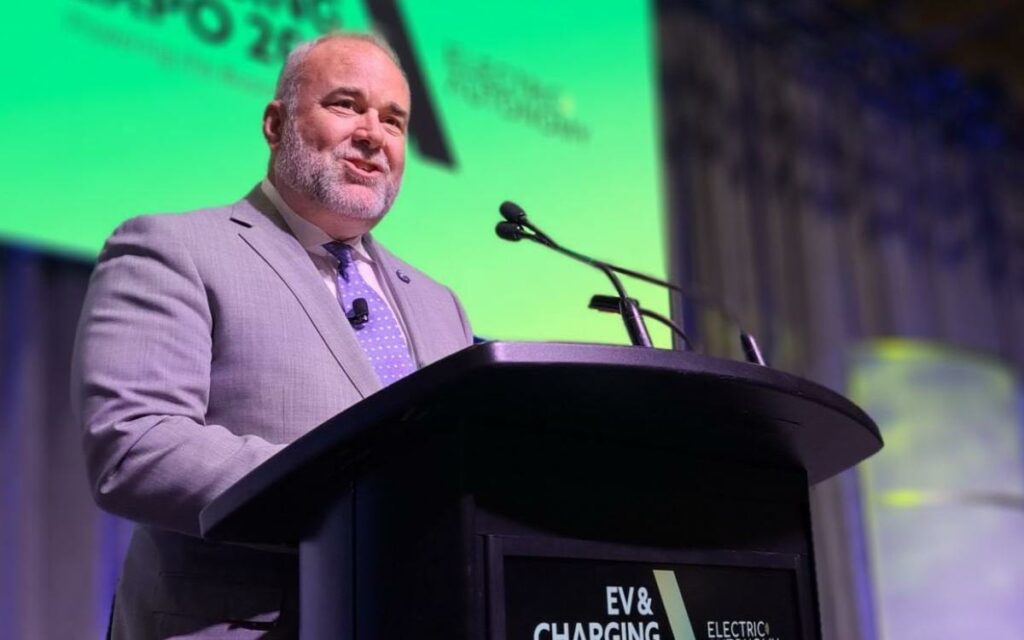
Blackouts, brownouts, increased costs and the like, just how far is the province willing to go to close the carbon gap and achieve the federal government’s audacious environmental goals. Pictured is Minister of Energy Todd Smith. Photo credit: Twitter/Todd Smith
Right now, Ontario’s electrical power grid is already 90 per cent non-carbon emitting, carbon emissions being considered a significant contributor to climate change.
How much risk is Ontario willing to take with its energy supply in order to meet the federal government’s goal of 100 per cent non-carbon emissions, the so-called “net zero” Holy Grail, by 2035?
As we create more gadgets and vehicles to plug into the grid, will the power be there? Or will the push to a “net-zero” electricity grid to fight climate change put that supply at risk?
It is a worrisome question because the answer is not clear.
Ontario’s Energy Minister Todd Smith stated earlier this month that “we have a (electrical) grid in Ontario that is the envy of all jurisdictions in North America – one that’s clean, one that’s affordable and one that’s reliable and one that’s safe.”
He was responding to an Opposition question in the Legislature from New Democratic Party critic Peter Tabuns. It was sparked by the most recent report from the North American Electric Reliability Corporation, an international regulatory body that enforces reliability standards on grids in the United States, Canada and parts of Mexico.
The report warned that two-thirds of North America could experience energy shortages should there be a particularly hot summer this year. It then singled out Ontario, warning that “Ontario has entered a period during which generation and transmission outages will be increasingly difficult to accommodate… for the foreseeable future.”
The province’s own Independent Electricity System Operator (IESO) said last year that shortages could occur as early as 2026.
Whatever the timeline, the key question is how to meet demand in an environmentally sound way? Unfortunately, politics, as always, is complicating the picture.
Many voices are pushing the province to go all in on “green” energy sources – wind, solar and water. The North American agency encourages “increased, rapid deployment of wind, solar and batteries.”
Premier Doug Ford’s government was roundly criticized for cancelling over 700 renewable energy source projects when it came to office in 2018. The reason was that the price of the long-term energy contracts was much higher than the cost of traditional sources like hydroelectric, nuclear, and natural gas.
While some now argue that such green energy sources are cost competitive, the U.S.’ recent approach indicates otherwise. Its Inflation Reduction Act requires taxpayers to subsidize wind power generators, for example, for half of their capital costs, plus a kilowatt per hour subsidy that all adds up to about 100 per cent of their costs.
But set aside the issue of cost for a minute and remember that wind and solar are notoriously fickle. In the summer of 2020, California’s electrical grid failed due to an overreliance on solar power which could not meet the need. A year later, the Texas grid failed because its wind turbines were not able to perform during several days of extreme winter weather. The fatal flaw – wind doesn’t generate power when it doesn’t blow, nor the sun when it doesn’t shine.
Last summer, about eight per cent of Ontario’s power came from wind and solar with almost half coming from nuclear power. Despite the environmental critics, nuclear has proven to be a reliable, cost-effective supplier. But the province’s existing plants are scheduled for major refurbishing and potential de-commissioning within the next few years.
To try to fill the gap, Ontario has launched an initiative to build seven, large-scale storage batteries to support current and expanded wind and solar production – storing the power for later use when wind and solar are down. But they are several years away.
The province has also launched a project to build small, modular nuclear reactors at its Darlington site, but again, even if all goes according to plan, it will be 2028 before that power is available.
Ontario is also expanding its natural gas generation capabilities. Natural gas is a relatively low carbon energy source and has the added advantage of being able to quickly ramp up or down to meet energy needs.
But this has caused great consternation among environmentalists, including the federal government which has passed legislation to ban natural gas generation by 2035. This makes it very difficult for the province to contract with new suppliers if their plants can’t operate past the next decade.
Ontario’s economy and its quality of life require a dependable, flexible, cost-effective electrical grid. Let’s not risk it on a quest for “net zero” when the province’s current contributions to global warming are not even a rounding error.

Janet Ecker is a former Ontario Finance Minister, Minister of Education, Minister of Community and Social Services and Government House Leader in the governments of Premier Mike Harris and Premier Ernie Eves. After her political career, she served as the founding CEO of the Toronto Financial Services Alliance, a public-private partnership dedicated to building Toronto region into an international financial centre. She currently sits on a number of corporate and non-profit boards, agencies and advisory committees.
Ms. Ecker received the Order of Canada for her public service contributions and was recognized as one of the “Most Influential People in the World’s Financial Centres” by Financial Centres International. She also received a “Canada’s Most Powerful Women: Top 100 Award” from the Women’s Executive Network and the Richard Ivey School of Business, among other awards. She is also one of the founders of Equal Voice, a national, multi-partisan organization working to elect more women.






